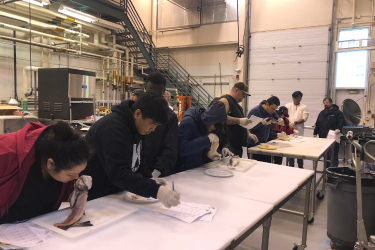Where did you grow up?
I grew up in Lyon, France. The capital of gastronomy!
Where did you go to school and in what subject did you get your degree(s)?
I left France after high school to attend college in the United States at American University in Washington, DC. There I double majored in Environmental Studies and Marine Science. I took a couple of years off school to do various internships and decided to go back in 2012 to pursue a doctorate degree. By 2018, I earned my degree at the Virginia Institute of Marine Science at the College of William & Mary where I worked on improving stock assessment and management of bluefin tunas, under the supervision of Dr. John Hoenig.
How did you come to work at the Southeast Fisheries Science Center?
My first connection with the Southeast Fisheries Science Center was in 2011 when I interned with the Shark Population Assessment group in Panama City, Florida. It was, by far, my favorite internship experience (what’s not to like about spending your days tagging sharks and tracking down the elusive smalltooth sawfish!) and put NOAA on my radar.
While finishing my degree I obtained a Sea Grant fellowship, which allowed me to work closely with scientists from the Southeast Fisheries Science Center’s Highly Migratory Species Branch located in Miami, Florida. These collaborations continued when I started working for the International Commission for the Conservation of Atlantic Tunas. Every few months, I would get the chance to meet up and work with the scientists at the center during tuna data and assessment workshops overseas. As I was approaching the end of my contract with ICCAT, a stock assessment position opened up at the center’s Miami facility. I eagerly applied and here I am!
What do you do at the science center?
I am a stock assessment analyst in the Gulf of Mexico Branch. Most of my time is spent modeling fisheries and fish population dynamics to estimate current and future stock abundance trends, and provide scientific advice to fisheries managers on the sustainability of fished stocks. I pursue collaborative research both nationally and internationally. I am currently interested in fish age and growth, tagging studies (including close kin mark-recapture) and their use in stock assessment, as well as linking population processes to environmental covariates in stock assessments. Additionally, I am heavily involved in improving scientific workflows and collaborations through open data science and automation.
What do you like most about your position?
The people! I really like my team and both the internal and external collaborators I’ve had a chance to work with. I also really enjoy seeing how impactful our work is and the positive outcomes it has on biodiversity and fisheries.
What advice would you have for someone interested in a career at NOAA Fisheries?
I would encourage anyone interested in a career at NOAA Fisheries to intern or collaborate with folks working there to get exposure to the types of careers available to them. In participating in internships and professional meetings, I discovered that I did not like what I thought I liked, and liked what I did not even know existed! There are so many different career opportunities at NOAA Fisheries, so talk to insiders, attend scientific meetings, and get firsthand experience. These experiences help build confidence and, if you are still undecided about graduate school, internships can make your decision process a lot easier!
What do you like to do outside of work?
I like to be outside as much as possible. Weekly biking, paddle boarding, and snorkeling with my husband have recently morphed into long walks and stroller jogs now that we have a (not so) little baby. I also love to cook, travel, practice yoga, scuba, snorkel and play music as loud as my neighbors allow.






